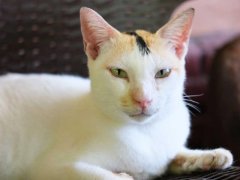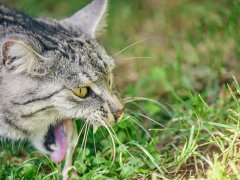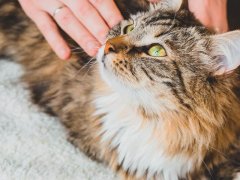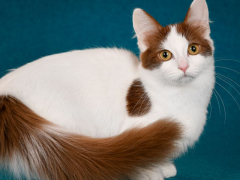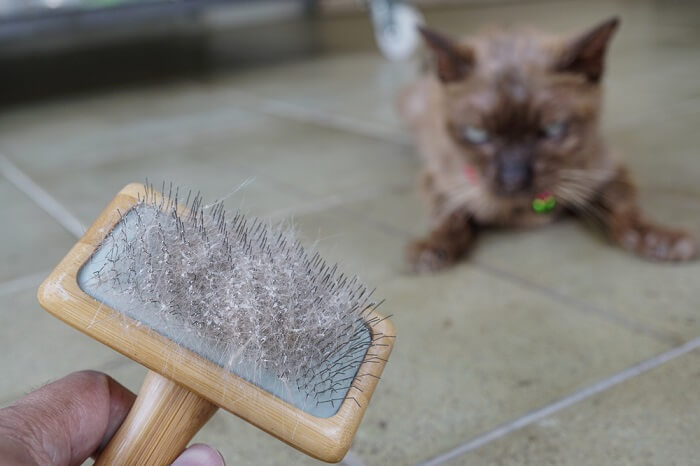
It seems cats are always grooming themselves, giving themselves a shiny and slick hair coat. So why is it that some cats have big white flakes of dandruff along their backs?
The skin is composed of many cells that are constantly being turned over, meaning as old cells die, new ones develop. Dead skin cells are known as dander, differant than dandruff. Most of the time, dander is so small that you do not notice it. However, if the skin cells are larger and they mix with the oil on the skin, they become flakes of dandruff.
In this article, you’ll learn the details on cat dandruff and how to treat it.
Causes of Cat Dandruff
Dandruff is caused by a number of different conditions. The most common causes of dandruff are environmental factors that lead to unhealthy, flaky skin.
Dietary Causes
Omega-3 fatty acids found in certain oils help keep your cat’s skin healthy and the coat shiny. A poor-quality diet may not have high enough oil content or the wrong type of fatty acids making the skin dry and unhealthy.
Fish oils are an excellent source of omega-3 fatty acids and feeding a fish-based cat food can help prevent dry skin that may lead to dandruff. Wet foods tend to have a higher concentration of fatty acids than dry kibble.
Omega-3 fatty acids are also available in many over-the-counter supplements. Before you add a supplement to your cat’s diet, be sure to speak with your veterinarian. Cats absorb fatty acids differently than people and your DVM will be able to pick the right one for your cat.
Poor Grooming
Cat owners are often surprised at how much time cats spend grooming. When cats groom, they are distributing the skin’s natural oils throughout the body, giving them healthy skin. Some cats are not able to groom themselves causing dander and oil to build up.
This is especially common in overweight cats that are not able to reach their back or in older cats that may have arthritis and are too painful to reach around to groom themselves.
Long-haired cats that are shaved may develop dandruff because the guard hair coat has been removed and the skin is more exposed to a dry environment. Talk with your groomer to determine if shaving is necessary.
Mites
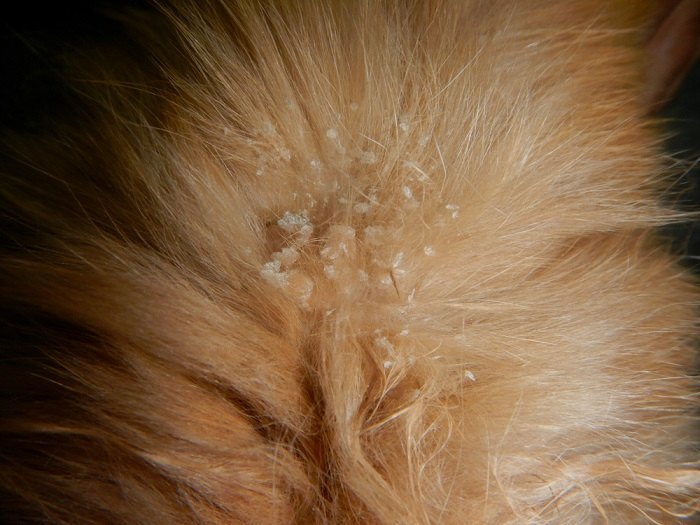
External parasites, such as cheyletiella mites shown in this image, can contribute to dandruff in cats
Cheyletiella mites can be a cause of dandruff in cats, dogs, and rabbits. These mites may spread from pet to pet in your house.
Cheyletiella mites live under the first layer of the skin and cause heavy scaling and flaking of the skin. The scales can sometimes be seen moving from the mites giving this condition a nickname of “walking dandruff”. Some animals infected with Cheyletiella may be very itchy but others are not bothered by it at all.
Although Cheyletiella mites prefer to live on cats and dogs, people can pick up the mites from their pets so it is important to treat this condition properly and under the guidance of your veterinarian. People should consult their physician if they develop a red, itchy rash.
Fleas
As the fleas bite the cat, the females are laying eggs throughout the skin. You may never see a flea on your cat as they tend to hide in the fur and your cat may swallow the fleas when grooming, but “flea dirt” is often visible throughout the skin.
Flea dirt is the excrement of the flea that the larvae feed on. It is small and black in color, looking like little black dots, but will turn into a rusty brown or red when wet because it is composed of digested blood.
Some cats have an allergic reaction to flea bites, leading to extreme itchiness and hair loss. In some cats, it only takes one or two fleas to cause a severe reaction, so even if you do not see a flea or flea dirt on your cat, your veterinarian will likely recommend treating your cat for fleas, especially if you have an outdoor cat.
Ringworm Infection
Ringworm is a dermatophyte fungal infection that can infect any mammal, including humans. In most animals, ringworm causes round hairless patches that are red and itchy, but some cats will be carriers of ringworm, meaning the dermatophyte can be found throughout the skin and hair but does not cause solitary lesions.
These cats are often not itchy but will have flaky skin and dandruff. Ringworm is diagnosed either through a fungal culture or a PCR test that can be done through a veterinary laboratory. Ringworm can pass from a cat to a human very easily so this is another condition that is important to treat properly.
Allergies
Many cats with dandruff have allergies. In dogs and cats, allergies cause a breakdown of the skin barriers causing moisture to leave the skin and bacteria and yeast to travel deeper. In many cases the skin is itchy and your cat may have bald patches throughout her fur from licking and scratching.
Pets can have allergies to protein in their foods and/or environmental allergies such as dust mites, trees, or pollen. A veterinary dermatologist can perform allergy testing to help determine what your cat is allergic to and discuss different treatment options.
When to Call the Vet
Cats with mild cases of dandruff are not of huge concern, and there may be some options to try at home before seeking veterinary advice.
However, cats who have itchy, sore skin should be taken to a DVM veterinarian. Itchy cats may groom themselves more than usual, scratch, lick or rub at sore areas. Sore skin can present as red patches, rashes, hair loss and eczema-like symptoms.
If your cat has a lot of dandruff, has other dermatological symptoms, or seems unwell in any way, always take them to see a vet.
Treating Dandruff in Cats
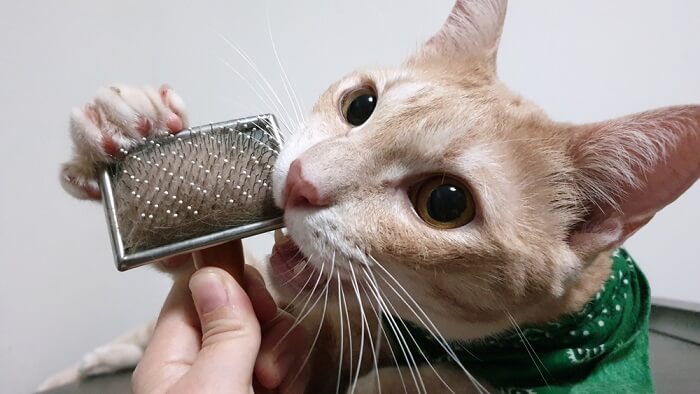
There are several ways to treat your cat’s dandruff at home, including dietary improvements and regular grooming.
Dandruff is caused by an underlying disorder with the skin and the only way to get rid of dandruff is to treat the underlying cause. It may be something as simple as brushing your cat a few times a week or changing your pet’s diet to higher quality food.
Start with brushing your cat daily to help remove dead skin cells and move the natural oils around the skin. You may want to switch to a high quality wet food or add an omega-3 fatty acid supplement. A humidifier may be helpful if you have dry air.
Do not use over the counter dandruff shampoos or products for humans.
If your cat is also scratching, showing other symptoms, or if you are not seeing an improvement with regular brushing, make an appointment with your veterinarian to make sure your pet doesn’t have an underlying medical disease.
Specific treatments will depend on the cause. Parasites, such as mites and fleas, are fairly easily treated with anti-parasitic medication. Infections such as ringworm can also be treated, but may require long courses of anti-fungal medications. Allergies can also be successfully managed, although not cured.
Prevention of Dandruff in Cats
Dandruff is usually caused by an underlying condition causing excess shedding of the skin. Allergies, parasites, infections, diet and poor grooming can all play a role in dry skin dandruff formation.
Here are some top tips for skin management in cats:
- Feed a high quality diet, which includes essential fatty acids
- Have a consistent grooming regime, allowing regular brushing and inspection of the skin
- Use anti-parasitic treatments when necessary, as recommended by your veterinarian
Conclusion
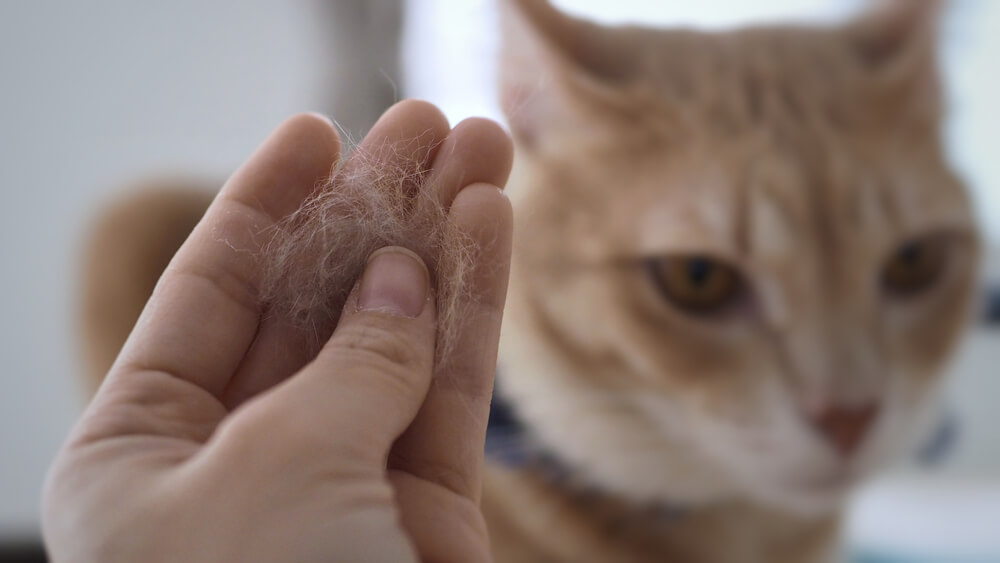
A lot of cats have dry skin, but not all of these cats will develop dandruff. There is usually an additional underlying cause leading to increased shedding of skin cells and flaky skin.
Cat dandruff can be caused by many different things, and there is no easy fix. If you notice that your cat is developing dandruff, isn’t grooming as much, seems to have dry skin, suffers from obesity, or if there is a change in the haircoat, contact your veterinarian.
